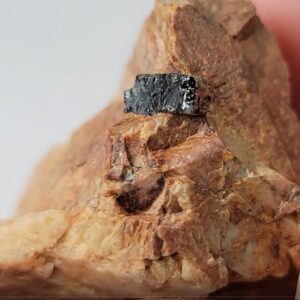Er – Erbium
products and information
Showing all 4 results
Euxenite-Y
Xenotime
Gadolinite
According to Mindat, there are only 5 known and named minerals containing Erbium in any substantial quantity:
(However, Wikipedia states, “The principal commercial sources of erbium are from the minerals xenotime and euxenite”
and that it was first discovered within Gadolinite)
| · ‘Arrhenite’ | (Y, Er, Ca, Zr, Ta, Si, O) |
| · ‘Bodenbenderite’ | (Mn,Ca)4Al(Al,Yt,Er)(Si,Ti)3O13 |
| · Caysichite-(Y) | (Ca,Yb,Er)4Y4(Si8O20)(CO3)6(OH) · 7H2O |
| · ‘Risörite’ | (Y,Er)(Nb,Ti,Ta)(O,OH)4 |
| · ‘Yftisite-(Y)’ | (Y,Dy,Er)4(Ti,Sn)(SiO4)2O(F,OH)6 |
From Wikipedia:
Erbium (for Ytterby, a village in Sweden) was discovered by Carl Gustaf Mosander in 1843.[32] Mosander was working with a sample of what was thought to be the single metal oxide yttria, derived from the mineral gadolinite. He discovered that the sample contained at least two metal oxides in addition to pure yttria, which he named “erbia” and “terbia” after the village of Ytterby where the gadolinite had been found. Mosander was not certain of the purity of the oxides and later tests confirmed his uncertainty. Not only did the “yttria” contain yttrium, erbium, and terbium; in the ensuing years, chemists, geologists and spectroscopists discovered five additional elements: ytterbium, scandium, thulium, holmium, and gadolinium.[33]: 701 [34][35][36][37][38]
Erbia and terbia, however, were confused at this time. A spectroscopist mistakenly switched the names of the two elements during spectroscopy. After 1860, terbia was renamed erbia and after 1877 what had been known as erbia was renamed terbia. Fairly pure Er2O3 was independently isolated in 1905 by Georges Urbain and Charles James. Reasonably pure erbium metal was not produced until 1934 when Wilhelm Klemm and Heinrich Bommer reduced the anhydrous chloride with potassium vapor.[39] It was only in the 1990s that the price for Chinese-derived erbium oxide became low enough for erbium to be considered for use as a colorant in art glass.[40]
According to wikipedia –
Lasers and optics
A large variety of medical applications (i.e. dermatology, dentistry) utilize erbium ion’s 2940 nm emission (see Er:YAG laser), which is highly absorbed in water (absorption coefficient about 12000/cm). Such shallow tissue deposition of laser energy is necessary for laser surgery, and the efficient production of steam for laser enamel ablation in dentistry.[45]
Erbium-doped optical silica-glass fibers are the active element in erbium-doped fiber amplifiers (EDFAs), which are widely used in optical communications.[46] The same fibers can be used to create fiber lasers. In order to work efficiently, erbium-doped fiber is usually co-doped with glass modifiers/homogenizers, often aluminium or phosphorus. These dopants help prevent clustering of Er ions and transfer the energy more efficiently between excitation light (also known as optical pump) and the signal. Co-doping of optical fiber with Er and Yb is used in high-power Er/Yb fiber lasers. Erbium can also be used in erbium-doped waveguide amplifiers.[9]
Other applications
When added to vanadium as an alloy, erbium lowers hardness and improves workability.[47] An erbium-nickel alloy Er3Ni has an unusually high specific heat capacity at liquid-helium temperatures and is used in cryocoolers; a mixture of 65% Er3Co and 35% Er0.9Yb0.1Ni by volume improves the specific heat capacity even more.[48][49]
Erbium oxide has a pink color, and is sometimes used as a colorant for glass, cubic zirconia and porcelain. The glass is then often used in sunglasses and cheap jewelry.[47][50]
Erbium is used in nuclear technology in neutron-absorbing control rods.[9][51] or as a burnable poison in nuclear fuel design.[52]
Biological role and precautions
Erbium does not have a biological role, but erbium salts can stimulate metabolism. Humans consume 1 milligram of erbium a year on average. The highest concentration of erbium in humans is in the bones, but there is also erbium in the human kidneys and liver.[9] Erbium is slightly toxic if ingested, but erbium compounds are not toxic.[9] Metallic erbium in dust form presents a fire and explosion hazard.
Sweden
Québec
Germany
Italy
Japan
Malawi
Australia




